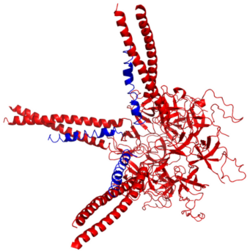User:Coiledcoil/Pup
- linking Prokaryotic ubiquitin-like protein at the top here for convenience
| Pup-like protein family | |||||||||||
|---|---|---|---|---|---|---|---|---|---|---|---|
 Three prokaryotic ubiquitin-like proteins (blue) bound to proteasomal ATPase Mpa (red) | |||||||||||
| Identifiers | |||||||||||
| Symbol | Pup/Mpa PDB:3M9D | ||||||||||
| Pfam | PF05639 | ||||||||||
| |||||||||||
Prokaryotic ubiquitin-like protein (Pup) is a functional analog of ubiquitin found in the prokaryote Mycobacterium tuberculosis.[1] Like ubiquitin, it serves to direct proteins to the proteasome for degradation. However, the enzymology of ubiquitylation and pupylation is different, owing to their distinct evolutionary origins. In contrast to the three-step reaction of ubiquitylation, pupylation requires only two steps, and thus only two enzymes are involved in pupylation.
Similar to ubiquitin, Pup is attached to specific lysine residues of substrate proteins by isopeptide bonds; this is called pupylation. It is then recognized by the protein Mycobacterium proteasomal ATPase (Mpa), which delivers the substrate protein to the proteasome for degradation by coupling of ATP hydrolysis.
The discovery of Pup indicates that like eukaryotes, bacteria may use a small-protein modifier to control protein stability.
Mechanism of pupylation
[edit]A sentence about how it's evolutionarily distinct - uses two enzymes instead of three, glutamine synthetasesexpand first part- Mechanism of pupylation: list names & explanations of enzymes.
The mechanism of pupylation is evolutionarily distinct from that of ubiquitination. It uses two enzymes as opposed to the three of ubiquitination, and these enzymes are descended from glutamine synthetase.[citation needed]
Similar to ubiquitin, Pup attaches to specific lysine residues of substrate proteins by forming isopeptide bonds.
- what protein adds it and how?
It is then recognized by Mycobacterium proteasomal ATPase (Mpa) by a binding-induced folding mechanism[2].
- expand the explanation of mechanism
Mpa then delivers the Pup-substrate to the 20S proteasome by coupling of ATP hydrolysis for proteasomal degradation.
- again, expand
Structure
[edit]- explain briefly what intrinsically disordered means, and expand w/ more content from paper
Pup is an intrinsically disordered protein.[3]
In 2010, scientists at the Brookhaven National Laboratory determined the X-ray crystal structure of the complex between Pup and its (delivery?) enzyme Mpa 3M9D and found that Pup binding to Mpa induces the folding of a unique alpha-helix.[2]
- reword "unique alpha helix" and explain
References
[edit]- ^ Pearce, M. J.; Mintseris, J.; Ferreyra, J.; Gygi, S. P.; Darwin, K. H. (2008). "Ubiquitin-Like Protein Involved in the Proteasome Pathway of Mycobacterium tuberculosis". Science. 322 (5904): 1104–1107. doi:10.1126/science.1163885. PMC 2698935. PMID 18832610.
- ^ a b
Wang T, Darwin KH, Li H (2010). "Binding-induced folding of prokaryotic ubiquitin-like protein on the Mycobacterium proteasomal ATPase targets substrates for degradation". 17 (11). Nature Structural and Molecular Biology: 1352–7. doi:10.1038/nsmb.1918.
{{cite journal}}: Cite journal requires|journal=(help) - ^ Liao S, Shang Q, Zhang X, Zhang J, Xu C, Tu X (2009). "Pup, a prokaryotic ubiquitin-like protein, is an intrinsically disordered protein". 422 (2). Biochemical Journal: 207–215. doi:10.1042/BJ20090738. PMID 19580545.
{{cite journal}}: Cite journal requires|journal=(help)
See also
[edit]External links
[edit]- PupDB, a database of pupylated proteins and pupylation sites.
((Category:Bacterial proteins))
